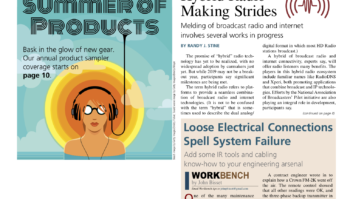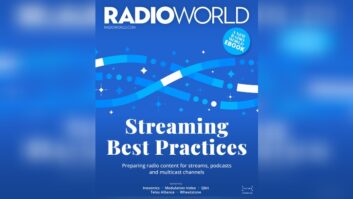
How many times does your radio station run a liner that says, “Find us on the app,” or “Listen on your computer at work”? Now, how often have you put yourself in the position of an online listener?
It is true that, even in this connected age, most radio listeners are pulling their signals off the tower and into a radio. But a look at the ratings books tells us that a growing number of listeners are online. In New York, WFAN’s stream has maintained a 0.3 share 6+ over the last four months. KFI in Los Angeles saw its online stream rise to a 0.8 in May, topping 14 over-the-air signals. Add KFI’s OTA and streaming numbers together, and that AM news-talker is number four in the number two market. Chicago has one stream in the book, San Francisco-Oakland-San Jose has two, and Dallas-Fort Worth has five.
[EAS Is Still Relevant as WEA Works Out Kinks]
This is a sign of the future. I often ask my college students to track a week of media consumption. When I started, the replies were the multiplatform mix you would expect. No more. This spring’s class was almost universally consuming media through their smartphones, and that was at one of the nation’s leading schools of journalism and mass communication.
Listeners expect what they hear on the stream to match what they hear on the radio. But for a variety of technical and sales reasons, there can be a major difference between the two. Some of those differences result in programming that would sound unacceptable, but it may seem no one in authority is listening.
Several years ago, I was introduced to the internet radio: a unit that looks like a tabletop radio but has a Reciva or similar chip that acts like a web browser for audio streams. I also have three radio apps on my smartphone. I spend many hours listening to streams from anywhere English is spoken. Too often, what I hear makes me cringe.
As an insider, I am patient and willing to put up with the occasional problem. But to a regular listener, some of what I hear would send me elsewhere. I would challenge a general manager, sales manager or program director to spend a week listening only to the streaming side of their stations. What they hear may be surprising (and not in a good way).
STREAMING: FIRST IMPRESSIONS
Any real estate agent will tell you about the importance of curb appeal, the first-glance look at a property that can make or break a sale. Your online stream may open with pre-roll message. Its length matters, especially since it is something listeners do not get when turning on their radio.
There are two ways stations can stream: just putting the entire program online as it appears off the tower. Or with a separate set of commercials for online listeners.
That second category can be further broken down to listeners who get spots for local advertisers while listening to an out-of-market station. (It can be a bit disorienting to hear an ad for a Phoenix furniture store on the stream of a Cleveland radio station.)
That first option is the easiest to do and the one with the least obstacles. However, it is obvious that some stations send the programming to the stream early in the audio chain. If the stream is not split after the processing, the station may sound different.
CHALLENGES
There are several challenges when the online and on-air commercials are separate:
- Timing: Sometimes a :30 is not a :30 and a :60 is not a :60. The online stopset plays out, then returns to the on-air program with the last few seconds of another commercial playing.
- Fill: When the CBS stations (prior to the Entercom acquisition) did not have an online commercial to run, listeners were treated to 30- to 120-seconds of a music bed and an announcer saying programming would return shortly. There is another group that covers with PSAs, but I have heard the same spot run back-to-back, or twice in the same break.
- Clash: This is what happens when the online automation and the on-air automation are not in sync. The on-air listeners hear a network newscast followed by a local update, a spot, and then traffic. The online listeners get the network newscast, a spot, the local update joined-in-progress, then the spot and traffic.
- Replacement: Some news-talk stations that have local newscasts and traffic reports replace them with spots in the online stream. Local listeners will notice the missing elements. Out-of-market listeners may be seeking to hear news from home or get an update on a breaking story directly from people in the market.
- Repetition: If a station has a dearth of online sponsors, that means fewer spots to schedule. If the advertiser has a rotation of one or two commercials, how often those ads repeat can quickly become obvious.
- Traffic: Your traffic team likely plays close attention to when on-air commercial runs are supposed to start and stop. Do they give the same attention to online scheduling? I was hearing the same ad for a Mother’s Day event well into June.
[Curran: Trade Deal Could Have Major Impact on Radio Industry]
As more listeners live their lives online, there are potentially millions of reasons to consider the online stream equally as important as the OTA signal. Program directors give a lot of thought to ways to increase TSL. Any of these six problems could be a tune-out factor for online listeners. That is something no station can afford.
Kevin Curran holds a Ph.D. from the University of Oklahoma’s Gaylord College. His research interests include broadcast history and media management. He teaches at Arizona State University’s Walter Cronkite School and College of Integrative Sciences and Arts, Grand Canyon University and Paradise Valley Community College.
Comment on this or any article. Write to [email protected].







